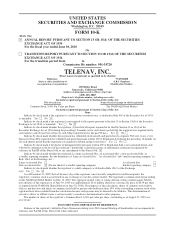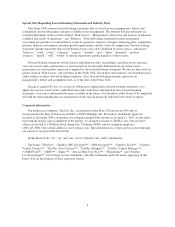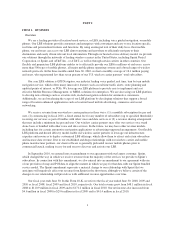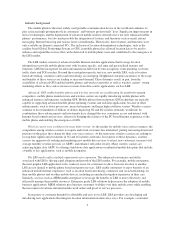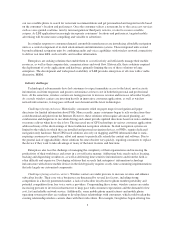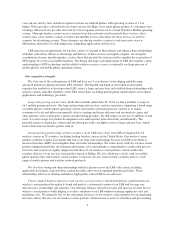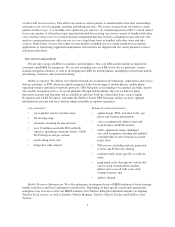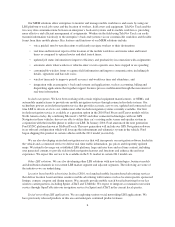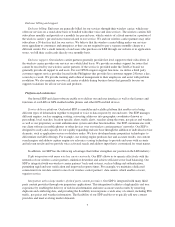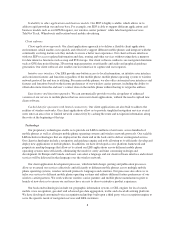TeleNav 2010 Annual Report Download - page 6
Download and view the complete annual report
Please find page 6 of the 2010 TeleNav annual report below. You can navigate through the pages in the report by either clicking on the pages listed below, or by using the keyword search tool below to find specific information within the annual report.can use a mobile phone to search for restaurant recommendations and get personalized and targeted results based
on the consumer’s location and preferences. Once the consumer selects a restaurant, he or she can access services
such as voice guided, real time, turn by turn navigation or third party reviews, or elect to receive a mobile
coupon. As LBS applications increasingly incorporate consumers’ locations and preferences, targeted mobile
advertising will become more compelling and valuable to advertisers.
In a similar response to consumer demand, automobile manufacturers are introducing affordable navigation
units as a central component of in-dash entertainment and information systems. These integrated units extend
beyond traditional navigation units by combining audio and voice capabilities with wireless network connectivity
to deliver real time LBS, such as traffic and weather information.
Enterprises are seeking solutions that enable them to cost effectively and efficiently manage their mobile
resources, as well as their company data, communications and work flow. Historically, these solutions required
the deployment of costly applications and hardware, primarily limiting the use of these solutions to large
enterprises. The development and widespread availability of LBS provides enterprises of all sizes with a viable
alternative, MRM.
Industry challenges
Technological advancements have led consumers to expect immediate access to the latest, most accurate
information, real time responses and greater convenience at lower cost in both their personal and professional
lives. At the same time, wireless carriers are facing pressure to increase revenue and increase subscriber loyalty.
As a result, wireless carriers are investing heavily in innovative consumer applications, as well as wireless
network infrastructure, to keep pace with end user demand and the latest technologies.
Challenges facing end users. Historically, consumers relied on paper maps for navigation and paper
directories for limited information about POIs. More recently, many consumers began to rely on directions they
could download and print from the Internet. However, these solutions often require advanced planning, are
cumbersome and dangerous to use while driving and cannot provide updated directions based on route conditions
or reroute a driver when he or she is lost. The increased use of GPS technology in various consumer applications
addressed many of the shortcomings of these traditional navigation solutions. In-dash navigation systems are
limited to the vehicle in which they are installed and personal navigation devices, or PNDs, require dedicated
navigation only hardware. Most GPS based solutions also rely on mapping and POI information that is static,
requiring consumers to expend time, effort and money to periodically refresh the content and software. Due to
the general lack of upgradeability, these solutions become obsolete very quickly, requiring consumers to replace
the device if they want to take advantage of many of the latest features and functions.
Enterprises also face the challenge of managing the complexity of their organizations and increasing the
productivity of their workforces and assets in a cost effective manner. Addressing basic needs such as locating,
tracking and dispatching workforces, as well as delivering time sensitive information to and from the field, is
often difficult and expensive. Developing solutions that securely link enterprises’ information technology
infrastructure with diverse mobile devices in the field typically requires costly, time consuming implementations
that rely largely on customized components.
Challenges facing wireless carriers. Wireless carriers are under pressure to increase revenue and enhance
subscriber loyalty. Their core voice businesses are threatened by several key factors, including strong
competition in a heavily penetrated market, a lack of subscriber loyalty due to phone number portability and
potential competition from free voice service providers. Compounding these issues, wireless carriers are under
increasing pressure to invest in infrastructure to keep pace with consumer expectations and the demand for low
cost, fast and reliable network service. Additionally, some mobile phone manufacturers and mobile phone
operating system providers are seeking to develop direct relationships with consumers, which could weaken the
existing relationship wireless carriers share with their subscribers. For example, Google has begun offering free
3

